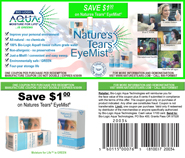Dry Eye
Eye Care News

Press Release
Dry Eye
Tear Film and Water
Water is the basis of life and eyesightTo understand dry eye syndrome, it is necessary to understand the critical role in vision, of the highly complex tear film that cover's and protects the eyes' exposed portions (called the "sclera" and "cornea"). Since the tear film is 98% to 99% water and the name "dry eye" suggests a lack of water, water is clearly the most important issue in any discussion of dry eye.
- The tear film lubricates and moistens the eye surface, refracts light and provides oxygen to living corneal cells not fed by blood vessels. You could not see without the tear film. As the name suggests, "dry eye" occurs when the "tear film" loses a significant portion of its water content.
- The tear film consists of three layers:
- The overlying "lipid" (or oil) layer. Among other functions, the lipid layer helps prevent water evaporation of from the aqueous layer. Lipids are secreted by many tiny "meibomian glands" located in the eyelid.
- The much thicker "aqueous" (water) layer. This middle layer also contains salt, proteins, growth hormones and disease fighting antibodies. The aqueous layer is secreted by the large "lachrymal glands," one gland per eye.
- The bottom "mucin" layer, which adheres the tear film to the eye surface. The mucin layer is essentially a thickened aqueous layer.
- When the aqueous layer loses water to evaporation, the concentration of non-water components, especially salt (electrolyte), increases. This results in stinging and burning. Insufficient tear film water can also cause small dry spots and ulcerations on the corneal surface, which can impair vision, cause discomfort or pain and lead to serious vision problems. Replace the water and symptoms should quickly resolve.
Related articles and sources
Tear Film and Treatment of Dry Eye Disease (RxSchool.com, 2005. William Mathers, MD)









